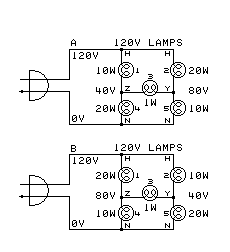PROOF THAT SWITCHING CIRCUITS SELECTING
BETWEEN SERIES AND PARALLEL CONNECTIONS
CAN NOT PROVIDE ALL POSSIBLE COMBINATIONS
AND ALSO BE NEUTRAL-SAFE AND POLARITY-SAFE
Many circuits exist for switching between series and parallel operation. But electrical safety
requires that screw-shell lampholders must have the screw shell on the neutral side of the power
and that the neutral must not be disconnected unless all live phases are also disconnected.
The page author wasted many hours trying to create switching systems that were always
neutral-safe and polarity-safe, until he made the following discovery:
It is impossible to create a series-and-parallel selection circuit that can provide all
possible combinations of series-and-parallel circuits and also that is neutral-safe and is
polarity-safe.
This means that any series-and-parallel circuit using line voltage must either not use
screw-shell lampholders or must not provide all possible series-and-parallel circuit
combinations.
Definitions:
- Neutral-safe - Any time throwing the switches opens the direct or indirect neutral
connection to a lamp, that action also opens any direct or indirect connections from the
hot wire to the lamp.
- Polarity-safe - Any combination of throwing the switches either puts the screw shell
of the lamp closer to neutral voltage than the center terminal of the lamp is or
disconnects the lamp.
The Proof:
The diagrams at the right show the proof arrangement. They are shown twice to keep
them on the screen.
 Part 1: Polarity safe:
Part 1: Polarity safe:
- Assume the wiring diagram A at the upper right was obtained by throwing the switches of
a 5-lamp series-and-parallel switching circuit so the lamps are connected as shown.
- Also assume that the circuit has some kind of interlocked switching to force it to be
polarity-safe and neutral-safe in the arrangement shown.
- Note the voltages on the lamp in the middle, as shown in diagram A. They show that the
left end of this lamp must have the screw shell, since it is closer to the neutral
voltage.
- Now without changing any switch positions in the series-and-parallel circuit, unscrew
the two bulbs on the left side of the diagram and put them in each other's sockets. Also
unscrew the two bulbs on the right side of the diagram and put them in each other's
sockets.
- The bulbs are now in the positions shown in diagram B.
- Note the voltages on the lamp in the middle, as shown in diagram B. They now show that
the right end of this lamp must have the screw shell, since it is closer to the neutral
voltage.
- Note that the switches on the series-and-parallel switching circuit have not been
touched. Yet, a circuit that was polarity-safe before is now not polarity-safe. This
means that no passive switching system that provides all possible circuit combinations
can guarantee that any lamp will be polarity-safe.
Thus, no series-and-parallel switching system that can provide all combinations can
be polarity-safe.
Note that circuits can be designed and built that are polarity-safe. They just can't
provide all possible combinations.
Some such circuits are shown here.
 Part 2: Neutral safe:
Part 2: Neutral safe:
- Set the switches to conform to diagram A so the lamps are connected as shown again,
and move the bulbs back to their original places.
(If starting here, assume the wiring diagram A at the right was obtained by
throwing the switches of a 5-lamp series-and-parallel switching circuit so the lamps
are connected as shown.)
- Since the left side of the middle lamp is closer to neutral voltage, you should be
able to throw a switch that disconnects the right end of the middle lamp without
disconnecting the left end. Do this. The middle lamp should go out.
- Now set the switches to conform to diagram A again.
- Now without changing any switch positions in the series-and-parallel circuit, unscrew
the two bulbs on the left side of the diagram and put them in each other's sockets. Also
unscrew the two bulbs on the right side of the diagram and put them in each other's
sockets. This is diagram B.
- Now again throw the switch you threw in step 2 to disconnect the right end of the middle
lamp.
- Note that the switches on the series-and-parallel switching circuit are in the same
positions they were set to in Step 2. Yet, a circuit that was neutral-safe before is now
not neutral-safe. This means that no passive switching system that provides all possible
circuit combinations can guarantee that any lamp will be neutral-safe.
Thus, no series-and-parallel switching system that can provide all combinations can
be neutral-safe.
Note that circuits can be designed and built that are neutral-safe. They just can't
provide all possible combinations.
Some such circuits are shown here.
Thus it is shown that no series-and-parallel switching circuit can provide all possible
circuit combinations and also be polarity-safe and also be neutral-safe.
Series-and-parallel circuits can be designed and built that are both polarity-safe and
neutral-safe. But they can't provide all possible combinations. Find some of them
here:
LINE VOLTAGE CIRCUITS SELECTING SERIES OR PARALLEL OPERATION OF
LAMPS AND IMPEDANCES
Find some circuits that can provide all possible circuit combinations, but which are not
polarity-safe or neutral-safe, here:
SIMPLE CIRCUITS SELECTING SERIES OR PARALLEL OPERATION OF LAMPS
AND IMPEDANCES
Using SEPAR I-5 to demonstrate the proof
LINKS
LINKS:
- SERIES AND PARALLEL CIRCUIT SWITCHING
- SIMPLE SELECTING SERIES OR PARALLEL OPERATION
- LIGHT BULBS, SPECTRA, and HUMAN VISION
- Computers, Science, and Measurement
 Part 1: Polarity safe:
Part 1: Polarity safe: Part 1: Polarity safe:
Part 1: Polarity safe: Part 2: Neutral safe:
Part 2: Neutral safe: